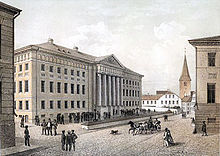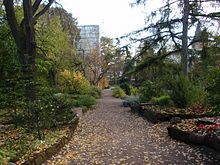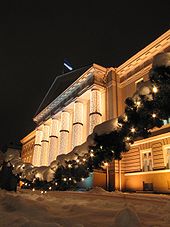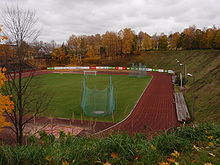- University of Tartu
-
For other universities that use the UT mnemonic, see UT.
University of Tartu Tartu Ülikool 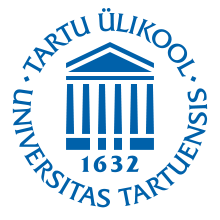
Latin: Universitas Tartuensis Established 1632 (closed 1710–1802) Type Public Rector Alar Karis Students 17,100 (2008) Location Tartu,  Estonia
Estonia
58°22′52″N 26°43′13″E / 58.38111°N 26.72028°ECampus Urban Former names Academia Gustaviana,
University of Dorpat/Yuryev,
Tartu State UniversityColours blue, white Nickname UT Affiliations CBUR, EUA,
Coimbra Group,
Utrecht Network ,
Atomium CultureWebsite www.ut.ee The University of Tartu (Estonian: Tartu Ülikool, Latin: Universitas Tartuensis) is a classical university in the city of Tartu, Estonia. University of Tartu is the national university of Estonia;[1] it is the biggest and highest-ranked university in Estonia. The University of Tartu is a member of the Coimbra Group and the Utrecht Network, and was established by King Gustavus Adolphus of Sweden in 1632, thus being one of the oldest universities in Northern Europe.
Contents
History
Academia Gustaviana
The Academia Gustaviana in the then Swedish province of Livonia was the second university founded in the Swedish Empire, following Uppsala University (in Uppsala, Sweden proper) and preceding the Academy of Åbo (in Turku, Finland). A precursor to the academy had been a Jesuit grammar school Gymnasium Dorpatense, founded by Stefan Batory (then king of Poland) in 1583 and existing to 1601, when Tartu (Dorpat) was under Polish rule.
The first students immatriculated between 20–21 April 1632. The opening ceremony of Academia Dorpatensis (Academia Gustaviana) took place on 15 October in the same year. The academy in Tartu functioned with Philosophy, Law, Theology and Medical Faculties enjoying the privileges of the University of Uppsala. On account of the Russian–Swedish war the University of Tartu moved to Tallinn in 1656 and in 1665 it closed down. In the 17th century the future outstanding Swedish scientists Urban Hiärne, Olof Verelius, Arvid Moller and others studied at the university. Among the academic staff were Friedrich Menius, the professor of history (the history of Livonia, the first scientific approach to Estonian folklore); Sven Dimberg, the professor of mathematics (the first in the world to deliver lectures based on Newton’s theory); Olaus Hermelin, the professor of rhetoric and poetry; Lars Micrander, the professor of medicine (the founder of balneology, the discoverer of natural mineral water springs); Georg Mancelius, professor of theology (author of the first Latvian-German dictionary in 1638[2]). In 1690 Tartu became a university town again. Academia Gustavo-Carolina shortly after that moved from Tartu to Pärnu as a result of the coalition against Sweden and the Great Famine of 1695–1697. Academia Gustavo-Carolina which had opened in Pärnu on 28 August 1699 was closed because of the surrender to the Russian forces on 12 August 1710 during the Northern War. According to the terms of the capitulation act the Russians agreed to maintain the university in Pärnu.[3] The university was reopened only in 1802 by the Baltic German Ritterschaften under the reform-minded Emperor Alexander I of Russia, to which Livonia then belonged.
Universität Dorpat
The Old Observatory of Tartu Observatory was completed in 1810. Friedrich Georg Wilhelm von Struve worked here.
The University was re-opened by the Baltic Germans in Estonia in 1802. The language of instruction at Dorpat was German from 1802 to 1893. During that time, Dorpat had a dual nature in that it belonged both to the set of German(-language) and Russian universities. Financially and administratively, the latter was more important; intellectually and regarding the professoriate and students, the former was more important (over half the professors came from Germany, at least another third were Baltic Germans). Among the 30 German-language universities, of which 23 were inside the German Empire, Dorpat was the 11th in size. In teaching, the university educated the local Baltic German leadership and professional classes as well as staff especially for the administration and health system of the entire Russian Empire. In scholarship, it was an international university; the time between 1860 and 1880 was its "golden age".
The freedom to be a half-German university ceased with the rise of nationalist tendencies in Russia, which held homogenization more important than retaining a bi-lingual university. Between 1882 and 1898, Russification in language, appointments, etc., was imposed, with some exceptions (such as the Divinity School, which the state feared would be used by the Orthodox clergy to teach dangerous Protestant views and was thus was allowed to continue in German until 1916). By 1898, when both the town and the university were renamed Yuryev, virtually all distinguished scholars from Germany had left. The University of Yuryev existed until 1918, when during part of the fall term, it was reopened, under German occupation, as Dorpat. Russian academic staff and students took refuge in Voronezh in Russia, giving rise to the foundation of Voronezh State University, which traces its own history back to the foundation of the University of Tartu and still holds several physical properties of the latter.
University of Tartu (1919–)
After Estonia became independent in 1918, the University of Tartu has been an Estonian-language institution since 1919. The university was named Ostland-Universität in Dorpat during the German occupation of Estonia in 1941–1944 and Tartu State University (Estonian: Tartu Riiklik Ülikool) in 1940–1941 and 1944–1989, during the Soviet occupation. During Soviet rule, although Estonian remained the principal language of instruction, some courses were taught in Russian, and there were several Russian curricula. Estonia regained independence in 1991, and the full recovery of academic autonomy of the University can be dated to 1992[citation needed].
The last decade has been marked by organizational and structural changes, as well as adaptations to various university models (American, Scandinavian, German) against the background of the Soviet and Baltic German past. Most recently, the university has been and is still being marked by the adaptation of the Bologna declaration in Estonia generally and Tartu specifically, leading to major changes in curricula and studies, as well as by strong organizational centralization attempts. Recent plans also include the abolition of the Chair system (an Americanization) and of the Faculties, which is supposed to lead to four large divisions (Humanities, Social Sciences, Natural Sciences, and Medicine) under briefly serving deans and rector-appointed financial administrators.
Buildings
The university’s four museums, its Botanical Gardens, and sports facilities are, by and large, open to the general public. The University possesses some 150 buildings, 30 of which are outside of Tartu. 31 of its buildings decorate the city as architectural monuments. However, the current reforms include attempts to sell, or have the state co-sponsor, several of these buildings and monuments, as well as sports facilities, as they are not seen as part of the university's mission proper.
At the same time, there are numerous recently constructed/renovated university buildings and student dormitories, such as the Technology Institute and the Biomedical Center.
Research
Lectinology, the science of lectins was founded at the University of Tartu in 1888 with the publication of Peter Hermann Stillmark's thesis about the isolation of Ricin.
At the University of Tartu, currently more than 3,300 scientific publications are produced every year. About half of all publications by Estonian scientists in journals (those covered by citation indexes like "SCI Expanded", "SSCI" or "A&HCI") are written by Tartu authors.
According to the university administration, the most remarkable recent research achievements have been in the fields of molecular and cell biology, gene technology, immunology, pharmacology, laser medicine, materials science, laser spectroscopy, biochemistry, environmental technology, computational linguistics, psychology, and semiotics.
The university cooperates with private enterprises, and acts itself as a nucleus for the development of spin-off firms (examples from recent past include Asper Biotech and others).
People
See: People associated with the University of Tartu
Students and teaching
Number of students is over 17,000. Language of instruction in most curricula is Estonian, but there are also several English language groups. Among the international programs, the most popular one is semiotics.
International cooperation
In the Erasmus programme for student exchange, the University of Tartu cooperates with more than 200 universities in 26 countries. In 2007/2008, there were about 175 Erasmus students at UT. The vast majority comes from Finland, Germany, Italy, France and Spain.[4]
The University of Tartu also participates in the Coimbra Group, the Utrecht Network and Atomium Culture. It has signed bilateral co-operation agreements with about 50 universities[5] (selection):
 University of Melbourne
University of Melbourne University of Toronto
University of Toronto University of Helsinki
University of Helsinki University of Turku
University of Turku Tbilisi State University
Tbilisi State University University of Göttingen
University of Göttingen University of Greifswald
University of Greifswald University of Hamburg
University of Hamburg University of Kiel
University of Kiel University of Münster
University of Münster University of Athens
University of Athens Corvinus University of Budapest
Corvinus University of Budapest Hokkaido University
Hokkaido University Waseda University
Waseda University University of Latvia
University of Latvia University of Vilnius
University of Vilnius University of Amsterdam
University of Amsterdam University of Groningen
University of Groningen Saint Petersburg State University
Saint Petersburg State University Moscow State University
Moscow State University University of Granada
University of Granada University of Gothenburg
University of Gothenburg University of Lund
University of Lund University of Uppsala
University of Uppsala University of Istanbul
University of Istanbul University of North Carolina at Greensboro
University of North Carolina at Greensboro West Virginia University
West Virginia University
Bibliography
- Mägi, Reet; and Wolfgang Drechsler (eds.) (2004). Kaiserliche Universität Dorpat 200, 370 Academia Gustaviana: Tartu Ülikooli juubel. Tartu: Tartu Ülikooli Kirjastus. ISBN 9985-56-950-4.
- Siilivask, Karl (ed.) (1985). History of Tartu University, 1632-1982. Tallinn: Perioodika.
- Die Universitäten Dorpat/Tartu, Riga und Wilna/Vilnius 1579–1979. Beiträge zu ihrer Geschichte und ihrer Wirkung im Grenzbereich zwischen West und Ost. Herausgegeben von Gert von Pistohlkors, Toivo U. Raun, Paul Kaegbein. Köln; Wien 1987 (Quellen und Studien zur baltischen Geschichte; 9). [Zweites Internationales Marburger Symposium zu Problemen der baltischen Sozial- und Kulturgeschichte]. [Lectures in German and English] ISBN 3-412-00886-9
- Palamets, Hillar; and Tullio Ilomets (eds.) (1982) (in Estonian). Alma mater Tartuensis: Tartu Riiklik Ulikool: 1632–1982. Tallinn: Eesti Raamat.
- von Engelhardt, Roderich (1933) (in German). Die deutsche Universität Dorpat in ihrer geistesgeschichtlichen Bedeutung. Reval (Tallinn): F. Kluge.
- Semel, Hugo (ed.) (1918) (in German). Die Universität Dorpat (1802–1918): Skizzen zu ihrer Geschichte von Lehrern und ehmaligen Schülern. Dorpat (Tartu): H. Laakmann.
See also
- List of early modern universities in Europe
- Tartu University Clinic
- Tartu University Press
- Tartu-Moscow Semiotic School
References
- ^ As stipulated by the § 2 (1) of the University of Tartu Act. http://www.legaltext.ee/et/andmebaas/tekst.asp?dok=X70009K2&keel=en
- ^ "Lettus, das ist Wortbuch sampt angehengtem täglichem Gebrauch der Lettischen Sprache". Rīga, 1638. (Pilnais nosaukums: "Lettus, Das ist Wortbuch Sampt angehengtem täglichem Gebrauch der Lettischen Sprache; Allen und jeden Ausheimischen die in Curland/Semgallen und Lettischen Liefflande bleiben und sich redlich nehren wollen zu Nutze verfertigt Durch GEORGIVM MANCELIVM Anno M. DC. XXXVIII").
- ^ Sirje Tamul on History of Tartu University
- ^ Erasmus programme at UT
- ^ UT's partner universities
External links
Universities in Estonia Universities Colleges & Academies Estonian Academy of Arts · Estonian Academy of Music and Theatre · Estonian Academy of Security Sciences · Estonian Aviation Academy · Estonian University of Life Sciences · Estonian Maritime Academy · Estonian National Defence College · Tallinn University of Applied Sciences · Tartu Art CollegeUniversities in the Baltic states Estonia Latvia Lithuania Coimbra Group of European research universities Aarhus · Barcelona · Bergen · Bologna · Bristol · Budapest · Cambridge · Coimbra · Dublin · Edinburgh · Galway · Geneva · Göttingen · Granada · Graz · Groningen · Heidelberg · Iaşi · Istanbul · Jena · Kraków · Leiden · Leuven · Louvain-la-Neuve · Lyon · Montpellier · Oxford · Padua · Pavia · Poitiers · Prague · St. Petersburg · Salamanca · Siena · Tartu · Thessaloniki · Turku I · Turku II · Uppsala · Würzburg
Coordinates: 58°22′52″N 26°43′13″E / 58.38111°N 26.72028°E
Categories:- University of Tartu
- Universities in Estonia
- 1632 establishments
- Educational institutions established in the 1630s
- Coimbra Group
- 17th-century establishments in Estonia
Wikimedia Foundation. 2010.

